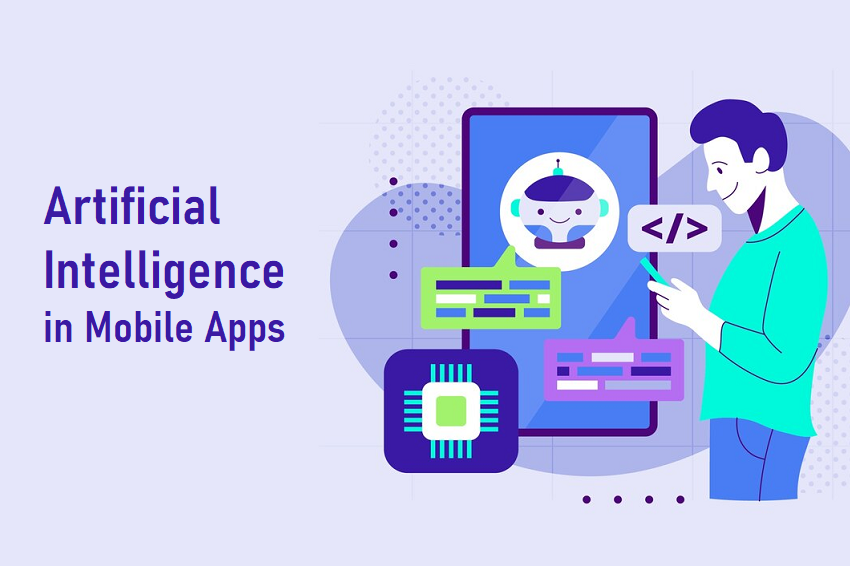Mobile Application Development with the help of AI is one of the new breakthroughs that help improve user experiences, and automate processes. Mobile application developers can take advantage of the potential of integrating Artificial Intelligence in mobile apps and enhance the performance of the apps by giving them the ability to read the customers’ minds.
From voice interaction and messaging to article imaging and predictive analytics, AI solutions are now making it possible for mobile applications to do the unimaginable. This article explores the various ways AI can be used in mobile app development, offering insights into the types of AI technologies, integration steps, tools, and future trends.
Introduction to Artificial Intelligence in Mobile Apps

AI is the new face of mobile application development, as it helps in providing a better user experience, personalized interfaces, and better and faster processing capabilities. It is the best way through which mobile apps can be designed to identify patterns of users, and their needs and provide solutions on their own without the need for human interference. As a result, integrating Artificial Intelligence in mobile apps has become a key strategy for developers looking to create innovative and competitive applications.
Types of AI Technologies Used in Mobile App Development
Machine Learning (ML)
Machine Learning is a division of AI which allows Mobile apps to learn over some time and eventually make improvements to their functionality without necessarily being instructed to do so by a programmer. It involves using patterns from data to predict outcomes, categorise information and even offer recommendations to the user.
Some typical uses of ML in mobile apps include behaviour analysis of the users in the apps, recommending content where the app delivers specific content depending on the user’s preference and many more.
For instance, in a particular company such as Netflix, the platform and interface uses ML to recommend shows or movies to watch based on people’s previous choices.
Further, it is applied in the efficiency of fraud, for example, apps that can detecting the abnormalities of transactions and notify experts to further check. In the next iterations, the used ML models learn from new data, their precisions increase and the interface reflects the improvements offering a better user experience..
Natural Language Processing (NLP)
NLP help mobile apps to undergo the process of recognizing, analyzing and even processing human language and providing meaningful and useful outputs. Sometimes it is as simple as being able to talk to an app by using voice commands by the use of voice assistants, chatbots or performing a text analysis feature.
This technology is crucial in enabling conversational interfaces and making the customer support services better. Another area in which NLP excels is evaluating sentiment in user feedback which makes the business understand the feelings of users about their products or services.
Through recognising context and differences in the language, the NLP makes it easier for the applications to offer more precise results. Thus it has a central role of improving user interactivity and satisfaction due to its usage of more natural language interactions.
Computer Vision
Computer Vision is a form of Artificial Intelligence technology, wherein, processing and comprehension of visual information from the mobile screen such as images and videos are enabled. It is indeed embraced in face detection, object identification and differentiation, picture categorization and even in augmented reality.
For instance, applications for security rely on computer vision to identify users via facial detection while applications for augmented reality immerse content on the actual environment. Retail applications can thus incorporate computer vision in helping the user to see how the product will be in their environment before buying.
Computer vision works by analyzing visual data which improves the functioning of mobile of apps to make them more engaging and easier for the user to interact with. It also has a great importance in the sphere of medicine and can be applied to analyze images in order to find out the disease of a patient.
Speech Recognition
Mobile Application Enabling refers to the ability of utilizing Speech Recognition technology whereby mobile apps can transform voice into text so that the user can engage the relevant mobile app through speech. This technology extensively utilized in Virtual Assistants, Voice search and Dictation solutions.
Of all the benefits that come with speech recognition, one of the most notable ones is that people with disabilities are able to use the product and, secondly, it is useful for people who are on the move. It is challenging to process different accents, languages, and even simple speech patterns hence needs the use of higher algorithms.
Siri, Google Assistant, and Alexa are few examples of smart virtual assistants which leverage the feature of Speech Recognition to issue out the command as given by the user. This also means that with the use of speech recognition, mobile applications create a more natural and effective user interface.
Predictive Analytics
Predictive Analytics measures future trends as well as results through the application of sophisticated statistical analyses, machine learning algorithms, and historical data. It is applied in mobile apps so as to predict users’ behaviour, the appropriate marketing approaches, and overall, enhance the level of engagement.
For instance, e-commerce applications employ machine learning to guess the potential purchase preference of the users of the applications. Mobile health applications are capable of analysing user information and estimating possible health complications and recommendations for their prevention.
Thus, it is considered that using predictive analytics, one can improve the decision-making process of businesses, develop customer experiences, and generate more revenues. This technology makes apps to offer proactive services hence making them more relevant and useful in meeting users needs.
Common Use Cases of Artificial Intelligence in Mobile Apps
Personalization and Recommendations
Some applications incorporate AI to sort information and preferences therefore presenting targeted content, products or advertisements which helps increase customer satisfaction.
Voice Assistants and Chatbots
AI enhances the interaction of mobile applications with the services where the customer can use his voice and get support with the help of the chatbot.
Image and Facial Recognition
Apps use AI for secure user authentication, photo editing, and identifying objects or faces in images, improving security and user experience.
Predictive Analytics
AI helps in predicting user actions and preferences based on historical data, which can be used for targeted marketing, inventory management, and more.
Augmented Reality (AR)
AI improves AR experiences due to the capability of machine vision when recognizing and understanding the world around thereby enabling interaction with virtual objects based on real-time values.
Steps to Integrate Artificial Intelligence in Mobile Apps
Define Your AI Use Case
When thinking about the process of integrating artificial intelligence in mobile apps the first brick that has to be laid is the definition of the problem or the use case that the AI solution will address. This could be anything from increasing the aspect of personalization to the users, increasing efficiency in human involvement in processes that can otherwise be automated or supporting customer relations through chatbots.
Defining AI in your mobile app helps demarcate the use of the tool in the application and set accurately defined aims. It is important at this stage to understand the end users, that is, what they need, and how AI can fit into this need! When building an app, when a problem is identified, it is easier for the developer to develop artificial intelligence solutions that solve precisely the particular problem highlighted thus making the application more efficient.
Choose the Right AI Technology
After getting to a clear understanding of the use case, the next step is to select the appropriate AI-tech to give the right result. Depending on your app’s needs, you might use ML for predicting patterns, NLP for handling text or voice input and CV for analyzing visuals.
This means that choosing the right technology leads to an efficient integration of AI into the APP. But it is necessary to know that technical availability and resources when choosing an AI technology are crucial factors too. When the technology is aligned with the particular application, the creators can deliver better AI-oriented functionalities.
Collect and Prepare Data
The primary source of any AI model is data, which means that only relevant and good-quality data must be collected. It should be related to the problem which AI is going to solve and it should consist of data similar to the data which can be encountered during practical usage.
Cleansing and structural arrangements of raw data in order to eliminate the noise forms part of data preparatory techniques. This step might also involve tagging data, especially in cases where the AI model to develop is based on supervised learning techniques which call for tagged data.
The collection and data preparation process is vital because datasets that are being fed to AI mainly determine the performance rate of an AI model. It is also important at this stage to protect the data and ensure that they conform to established laws.
Develop and Train AI Models
With the above data ready, the next process involves creating and training of the Artificial Intelligence models through proper frameworks like TensorFlow, Keras or PyTorch. This entails creating models that are capable of analyzing the information, trying to understand what the data means and then coming out with a prediction or conclusion concerning the information analyzed earlier.
When it comes to training, the model takes training data and continuously refines it with an aim of reducing errors and yielding high accuracy. In certain cases, training may be very involving and may call for optimization techniques so as to carry out the training faster. The accuracy on new data should be good for a well-trained in order to show that it is ready for the field.
Integrate AI Models into the App
Based on the AI models that have been created, the next viable operation is to incorporate them into the mobile application. This can be accomplished by utilizing APIs coming from cloud AI services or by integrating the AI models into the app’s code.
The integration process should make sure that the incorporation of the AI features to the app was done in a way that only enhance its interface as well as its functions. The AI processes have to be optimized so they do not slow down the app, or take a lot of resources from the user’s device.
The integration should also enable making modifications and enhancements to the AI models that is whenever new data is obtained or when there are developments in AI technologies.
Test and Optimize
The last step is to conduct the analysis of the application’s performance and validity for integrating with an AI system: to do this, the final concept of the application must be run through its paces and checked for weaknesses and strengths where the AI system could be integrated into the program.
Testing should include different scenarios and cases that should be tested to get sure the separate AI constructed features work and provide correct results. According to users’ experience with the testing of these AI models, further refinement and optimization of their performance and decreased latency may be required.
Out of all these methodologies, continuous monitoring and optimization are critical to sustaining the AI components since users’ behavior alters with time. Periodic edit of the AI models and feeding of the application with new data may make the app functional and current.
Popular AI Tools and Frameworks for Mobile App Development
TensorFlow Lite
TensorFlow Lite is a small modal of TensorFlow, which is designed and tailored to work with less powerful devices such as mobile and embedded devices. It affords on-device machine learning to effectively enable the apps to make inference with low delay and energy consumption. Don’t let the lowered suffix ‘Lite ‘fool you; TensorFlow Lite works well for most AI tasks as image recognition, natural language, and other.
Core ML
Core ML is Apple’s machine learning platform which lets developers easily add pre-trained AI models into their iOS applications. What it offers is tight integration with iOS applications, thus offering such capabilities as image processing, natural language processing, and speech recognition capabilities. The Core ML is designed to be lightweight and performant for the Apple ecosystems, making AI tasks quickly and efficiently accomplished, increasing the quality of experience.
Microsoft Azure AI
Basically, Microsoft Azure AI is a group of cloud-based artificial intelligence services and tools which can be included in the mobile applications to bring many AI functions. The provides features are machine learning, cognitive services and bot services which includes services like image recognition, language understanding and predictive analytics. Azure AI enables developers to create, train and deploy AI easily using the strength in Microsoft cloud.
Google ML Kit
Google ML Kit is a mobile development kit that aims to bring Google’s machine learning capabilities to Android and iOS projects. One of the resources includes the fact that it offers pre-built APIs for the most popular AI use cases including text recognition, face detection, barcode scanning, etc. That’s why the heart of ML Kit is simplicity and integration: anyone can put AI into apps without having to know too much about the topic.
Amazon AI
Introducing Amazon AI, services which can be used to add intelligence to mobile applications include the following; object recognition and analysis of images and videos through the Amazon Rekognition, building conversational interfaces utilizing Amazon Lex and converting text to speech through Amazon Polly among others. These services are also available online meaning that the AI support can be obtained in flexible and scalable manners to accommodate app needs. Amazon AI offers developers with complex AI features to incorporate to their applications without having to create models, thus saving a lot of time in its development.
Challenges and Considerations When Using AI in Mobile Apps
Data Privacy and Security
AI applications often require access to sensitive user data. It is crucial to implement robust data privacy and security measures to protect user information and comply with regulations such as GDPR.
Managing Large Data Sets
AI models require large amounts of data for training and improving accuracy. Managing, storing, and processing these data sets can be challenging, requiring efficient data management solutions.
Ensuring Real-time Processing and Low Latency
AI-powered mobile apps need to provide real-time responses to user actions. Optimizing AI models for low latency and ensuring they can process data quickly is essential for a smooth user experience.
Scalability and Maintenance
As user bases grow, AI models need to scale accordingly. Developers must plan for scalability and regular maintenance to ensure AI systems remain efficient and effective.
Future Trends of Artificial Intelligence in Mobile Apps
AI and IoT Integration
The combination of AI with the Internet of Things (IoT) will lead to more intelligent and context-aware mobile applications, offering users enhanced experiences and automation.
Advanced Personalization
AI will continue to evolve, enabling even more personalized user experiences, with apps tailoring content, recommendations, and services to individual preferences and behaviors.
Enhanced Augmented Reality
AI will play a significant role in advancing AR technology, creating more immersive and interactive experiences in mobile apps.
Voice-Activated and Conversational Interfaces
The use of AI for voice recognition and natural language processing will lead to more sophisticated voice-activated and conversational interfaces, making interactions more intuitive and user-friendly.
Improved AI Ethics and Transparency
As AI becomes more integrated into daily life, there will be a growing emphasis on ethical AI practices, transparency, and accountability in AI-powered mobile applications.
Conclusion
Artificial Intelligence has started becoming integrated into app development solutions across mobile applications where it is becoming the next big thing since it is even creating more opportunities for new improvements.
With machine learning, natural language processing, and computer vision in mobile application development, the developers can come up with meaningful and smart mobile applications that can adapt to the needs of the people in the society.
But, it is imperative to note that companies have to consider issues such as data privacy, ways of scaling up the entire process and processing data in real-time if they want their AI to work effectively.
With the progression of AI, the future of mobile apps is even more exciting, so the further development of apps constitutes a crucial field for developers and businesses.


